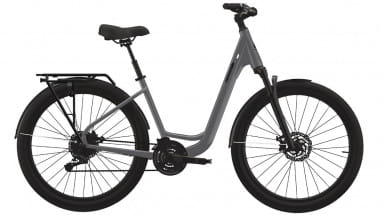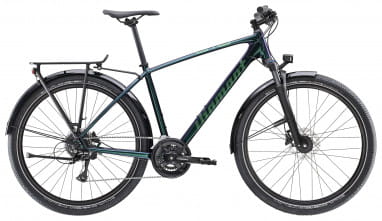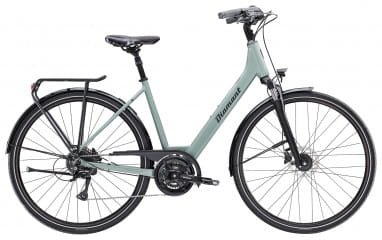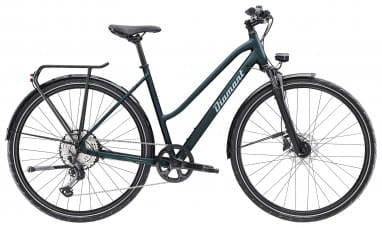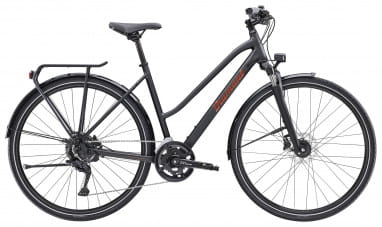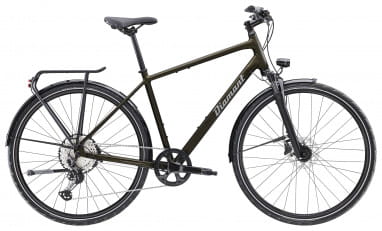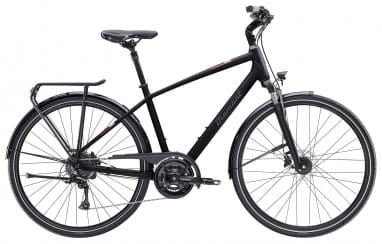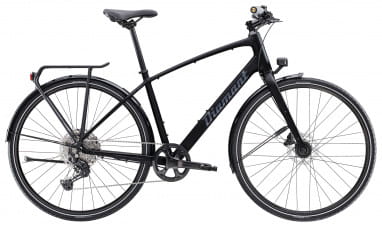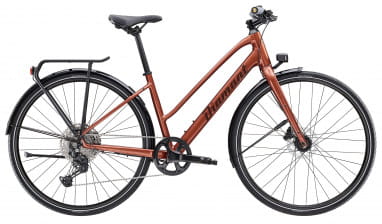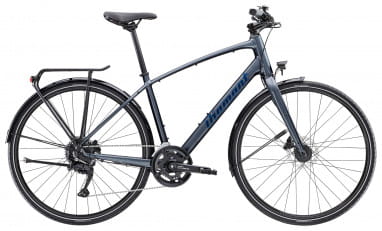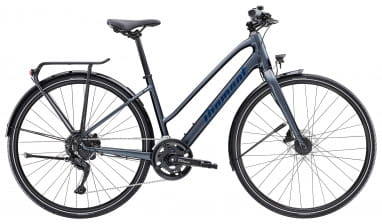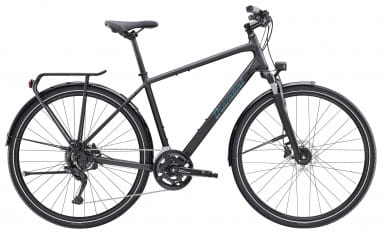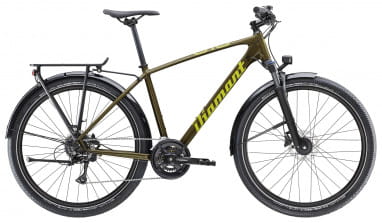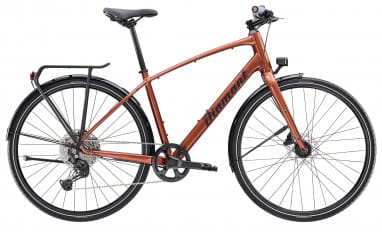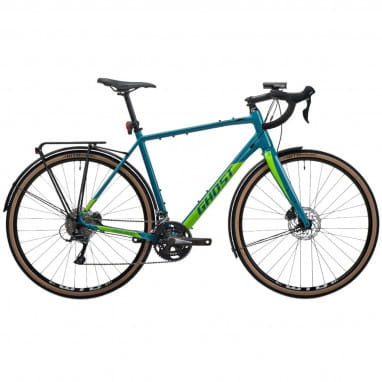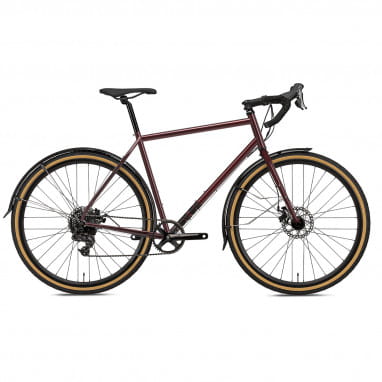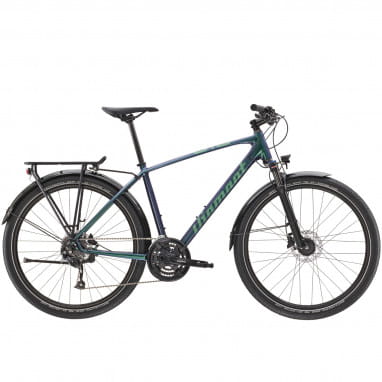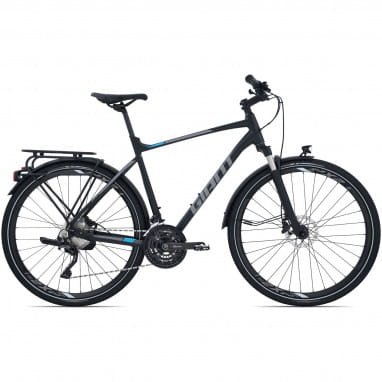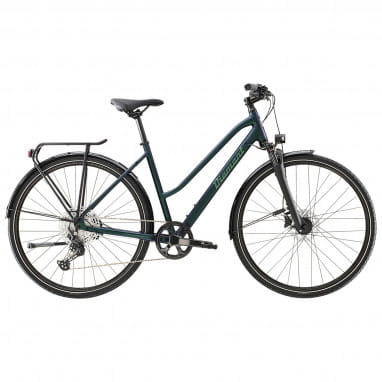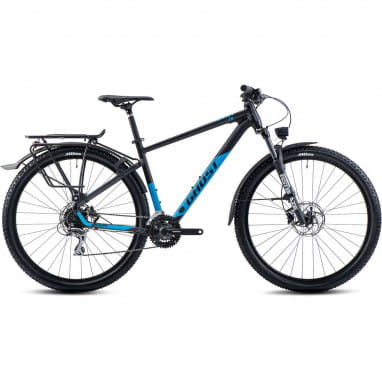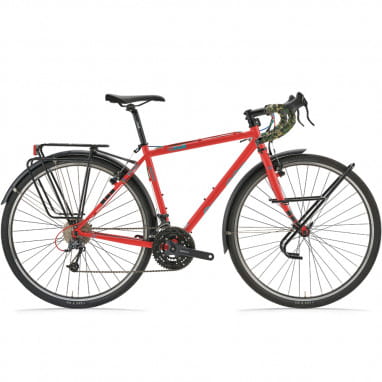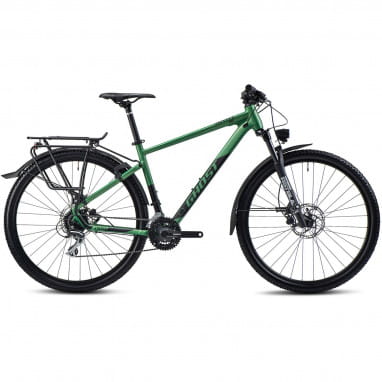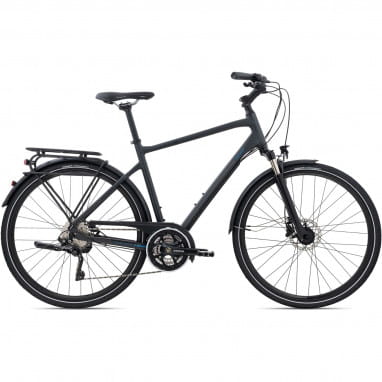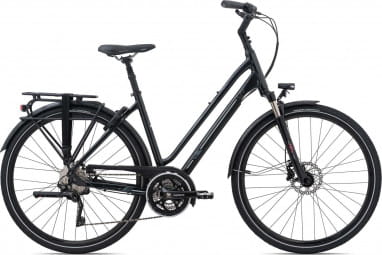Germany offers numerous, well-developed cycle paths. Even in distant countries, spectacular routes await you and your bike. However, if you are aiming for particularly far-ranging destinations, you should ride a bike that is comfortable to pedal for hours on end, on which you can store your luggage and which won't break down on the way. No other bike meets all these requirements as perfectly as a trekking bike. But what exactly makes a trekking bike?
The abbreviation:
What is a trekking bike - Things to know about touring bikes
Trekking bike, touring bike, expedition bike - which is which?
The three types of bike trekking bike, touring bike and expedition bike fall into the "trekking bike" section, you can easily sort them from small to large. However, this isn't about the size of the bike, it's about the size of the trail ahead of you
A touring bike is perfect for everyday rides and smaller tours. It's well-equipped and popular with commuters, but it's also fun on bike excursions and tours lasting a day or two.
A trekking bike is just right for active vacations and bike trekking.It's sturdily built and comfortable to ride, on a long-distance bike trail or multi-day tours you'll be well equipped.
An expedition bike is designed for real adventurers. These bikes are mostly made in manufactories, in terms of quality and reliability, they are top notch. On these bikes extreme bikers circumnavigate the globe, tour Mongolia or ride from Mexico to Tierra del Fuego.
The differences blur, though, depending on the manufacturer and model, or they're used interchangeably, so you should always take a look at the bike's exact specs to find out what it can do.
Increasingly common in bike trekking or bikepacking are bikes with a dropbar, which is a road handlebar. For more on this, check out our gravel bikes.
The features of a trekking bike
A trekking bike is built to provide the utmost comfort on the road. Therefore, attention is paid to ergonomics. Apart from that, the bikes are equipped to handle well on any terrain. Therefore, here like with gears or the size of the brake discs is not stingy, rather brings the bike a few grams of weight more and is durable and comfortable to ride for it!
- Gears on the trekking bike
While gear changes have been shrinking on other bikes lately, everything stays the same on the trekking bike. Many gears are trumps! In order to be able to adapt your bike to changing terrain, inclines or declines, a trekking bike has an extensive derailleur system. A 3x10 gear system with 30 gears is not uncommon here.
- The best brakes for a trekking bike
Trekking bikes ride (almost) exclusively with disc brakes. Their reliable braking effect is simply indispensable on long tours. Since they also decelerate safely in wet conditions, they also brake safely if you get caught in a downpour. Disc brakes also don't cause abrasion to rims, which is a huge advantage on long rides, because rims that rim brakes gnaw on have limited mileage.
- Comfortable on the road: ergonomic handlebars and saddles
On a trekking bike you are on the road for a long time. And you'd like to enjoy that comfortably and pain-free, right? That's why these bikes tend to have comfortable saddles, even the handles and handlebars are ergonomically designed. You can often adjust the angle of the stem on a trekking bike to make your riding position even more comfortable. With handlebar cranks you can vary the position of your arms while riding, which prevents fatigue. If your bike's saddle isn't feeling great, it's easy to replace it, find out more in our Bike Saddle Buying Guide.
When you buy a trekking bike, it probably already has all the add-on parts you could possibly want on board - from the fender to the lights to the side stand. Of course, a trekking bike also has one to three racks,one at the rear and lowriders at the front of the fork. If your bike doesn't have these parts, it probably at least has the mounting points for them. If so, you can buy everything separately from our Bike Accessories and bolt it on.
Durable Components
As with any other bike, a trekking bike is made to weigh as little as possible. Possible is the operative word here, however. There is no haggling over every gram, when push comes to shove, the more durable components always get priority here. Of course, your bike should weigh as little as possible. But when you're loading it up with your bikepacking gear, a brake system that weighs a few grams more, for example, won't make much of a difference. It's more important that it doesn't give up the ghost along the way.
Reliability counts!
The very last thing you need on a bike tour is a breakdown, right? That's why trekking bikes in particular are designed for absolute reliability. Durable frames and reliable components are the top priority here!
Trekking frames for men and women
A trekking bike puts you in a sporty but comfortable position. That means you sit relaxed and leaning slightly forward. Not upright like on a city bike, not as low as on a road bike or MTB.
Trekking frames are mostly diamond frames with a high top tube, but there are also many models with trapezoidal frames, here the top tube sits centrally between the bottom bracket and the saddle. You can also buyclassic women's bikes with a low entry with trekking equipment!
The frames are made of aluminium or steel. Carbon frames are rather rare in the trekking sector. Aluminum frames bring little weight, they have good stiffness values, which makes them very efficient. Steel frames are heavier, but the material gives a little on uneven ground, so it increases the ride comfort a little more.
Expedition bikes always have steel frames, the reason for this is quite exciting: a steel frame can be welded together after breaking. So you won't be stranded somewhere in the middle of nowhere, because even in the most remote area, if you're lucky, you can find someone with a welder.
A trekking bike has a suspension fork
On most trekking bikes, you'll find a suspension fork. They cushion your ride on uneven surfaces, shocks are not passed on to your arms and shoulders. So you're safe from premature fatigue or painful strains. Trekking bikes do not have a frame damper, it would absorb too much energy and make the bike unusable for long distances. For extra comfort, then, there is rather a suspended saddle.
The tires of a trekking bike
Trekking tyres skilfully bridge the gap between comfort, grip and efficiency. A wide tire bounces well, but its larger contact area creates more rolling resistance, so you'll have to use more muscle to get it moving. A chunky tire has more grip on changing surfaces than a smooth tire, but also requires more energy on your part to roll forward. That's why trekking tires are usually about 40mm to 50mm wide, and trekking skins have a distinct but not too chunky tread.
There's a wide range of touring e-bikes
If you're looking for a little help on the road, you'll be pleased to know there's a wide range of trekking e-bikes to choose from! The bike market offers a huge number of touring e-bikes in all kinds of configurations and designs. With these bikes, the main focus is on a large battery range, so you can also go on long bike tours without stopping to charge at the socket.
Even when bike-packing, an electric motor is sometimes very helpful, because with tent, sleeping bag and food, a large (and heavy!) amount of luggage comes together quickly!
If you want to buy a reliable, robust bike that's also comfortable to ride, you should go for our trekking bikes.
Is a trekking bike the right bike for you?
Basically, a trekking bike is a mile-eater. If you enjoy bike touring, a trekking bike is perfect for you. Even if you like active holidays and spending time in nature, a trekking bike is the optimal companion.
Basically, a trekking bike is a mile eater. If you want to enjoy bike touring, a trekking bike is perfect for you. Also, if you like to take active vacations and spend time in nature, a trekking bike is the perfect companion.
Thanks to its construction and tyres, it can cope with many different surfaces, both in the city and in the countryside, which is a great advantage. Cobblestones, dirt roads, forest tracks or asphalt, a touring bike can make headway anywhere.
It may not be as fast as a road bike, nor as off-road as a mountain bike, but it's also happy to do endurance training on two wheels. If you need a reliable bike for your everyday commute to the office or university, a comfortable, reliable bike certainly won't go amiss either. Its all-round features are not only practical on a big tour, they also make your everyday life easier.
Mudguards and tyres with good grip make touring bikes real all-weather bikes.
Touring bikes and trekking bikes are also available in numerous E-bike versions.
The features at a glance:
- Reliable and robust
- drivable on all surfaces
- best equipped
- weatherproof
How does a trekking bike ride?
A trekking bike is meant for long rides, and its handling is accordingly, scoring high on comfortable riding posture and good riding efficiency.
The frame material significantly affects the riding characteristics, while an aluminum frame is lighter and stiffer and therefore more efficient, a steel frame is heavier but gives a little when it gets bumpy, so it is more comfortable.
Wide tires iron out rough surfaces, but the tires don't roll quite as effortlessly as narrower wheels can. If you do a lot of off-roading and riding on dirt trails, you can reach for coats with lots of tread; if you ride mostly on trails and around town, smoother tires are more efficient. Special winter tires also give you good grip in snow and ice.
The handlebar also influences the handling, of course. Ergonomic flat bars, which are straight handlebars with a bit of sweep, allow you to have good control over your ride. With bar ends or trekking handlebars, also called butterfly handlebars, you can always move your hands to a different position and thus avoid one-sided strain.
The riding characteristics at a glance:
- comfortable
- ergonomically equipped, therefore suitable for continuous use
- Efficient or lighter, depending on the frame material
- Efficient or more off-road, depending on the nature of the tyres
- quiet
- sporty to comfortable
What are the advantages of a trekking bike?
Anytime, anywhere, if you wanted to sum up a trekking bike in two words, it would probably be these two. A trekking bike is a travel companion, your personal public transportation, a workout tool, a patient load hauler.
It works with its versatile tires on the road as well as the dirt trail, and thanks to good shifting groups downhill and up.
There's no such thing as bad weather for a true trekking bike, as it has mudguards that catch the rain before it lands in your face.
Lots of luggage isn't a problem, because it brings luggage racks with big payloads.
You don't have to worry about roadworthy equipment either, most touring bikes come with lights, reflectors and bells already fitted from the factory.
With all these practical aspects, comfort is not neglected! A touring bike delivers a comfortable, upright riding position. Not only do you have a good overview of the road traffic, you are also assured of the most beautiful views along the bike path. Anatomically shaped saddles and trekking handlebars let you enjoy your time in the saddle without any tension or pain.
Last but not least, trekking bikes are durable making them a solid purchase and very sustainable! A trekking bike is not a fad, thanks to its sturdy construction you can ride it for a long time. If you have it serviced every now and then, you can keep it for many years and not produce a pile of bike junk every few years.
Here's a tip for all parents: because trekking bikes have sturdy frames, good brakes, and grippy tires, they're optimal for towing a trailer. If you want to put your kids in a trailer, a trekking bike is the perfect towing machine! You can also attach a child seat to a trekking bike with a clear conscience.
The advantages of a trekking bike:
- can be used on many surfaces
- suitable for inclines
- large payload
- comfortable on bike tours, practical in the city
- best suited for bike trailer and child seat
- robust and durable
How much does a trekking bike cost?
With trekking bikes there is a moderate price range, the really, really expensive bikes tend to be found under mountain bikes and road bikes. Therefore, with a touring bike, you can get a lot of bike for relatively little money.
.
The entry-level class starts at 500 euros and goes up to about 800 euros. For a trekking bike, you have to expect slightly higher price tags than you would find on a city bike. In return, you get a robust and comfortable bike that will reliably handle your daily commute to work and is happy to take small tours. The components will probably be a bit heavier, and the frame will also weigh a bit more. Here you can gradually adapt the bike to your needs with small modifications and improve it with better tyres or a high-quality saddle.
.
A mid-range trekking bike costs around 800 to 1200 euros. The components and the frame become more durable and lighter, the radius of the bike expands. Not entirely unimportant: the braking systems are getting better. If you want to get on your bike in all weathers, you shouldn't buy a cheaper bike.
.
From 1200 euros to about 1600 euros, top trekking bikes cost. Here you get brand-name components that will last for many miles. Hydraulic disc brakes and trekking gears with a wide range make your ride easier. You can also find gravel bikes that are a lot of fun on bike tours in this price range. If you are planning long tours, you should go for this category, because not only the riding comfort increases with the price, but also the durability improves significantly.
.
The costs at a glance:
- Entrekking bikes for beginners are available from 500 and up to 800 euros
- Mid-range trekking bikes you can buy for 800 to 1200 euros
- Top bikes for big bike tours are available from 1200 euros
Trekking bike, mountain bike, road bike, gravel bike and city bike
.
Where exactly is the difference between a trekking bike and other types of bikes?
Trekking bike - Mountain bike
.
Both types of bikes are capable of off-road use, but as the terrain gets rougher, the trekking bike has to take a back seat. A mountain bike is expressly designed for off-road riding. A trekking bike can make headway on dirt roads or forest trails, but off a reasonably paved path is the end of the line.
But there are mountain bikes that definitely cut a fine figure on tour. You can also go bike touring with a cross country hardtail or a marathon hardtail. However, neither of them can hold a candle to a trekking bike in terms of comfort, and you will probably have to upgrade the practical equipment yourself, if that is at all possible.
.
Trekking bike - road bike
A road bike and a trekking bike have absolutely nothing in common! A road bike is light and fast, where a trekking bike is best equipped and comfortable.
Trekking bike - Gravel bike
.
A gravel bike is a real alternative to the trekking bike. If you want to combine the sleek looks of a dropbar road bike AND the practicality of a trekking bike, a highly fashionable gravel bike is perfect for you.
Trekking bike - City bike
.
A touring bike can do more or less the same things that a city bike can do - get to work in comfort, get around town safely, a practical full set of features, all of which apply to both types of bike. A trekking bike additionally plays out its capabilities on long distances and bike tours.
What should you look for when buying a trekking bike?
With a few simple questions, you can quickly find the right trekking bike or touring bike for you!
- Which is the right frame shape?
Trekking bikes come in many different shapes, so you have a free choice here. A bike in wave form (with a low entry) is particularly easy and safe to get on. These frames are especially good if you want to carry a child seat or a lot of luggage on the rack, because you don t have to wiggle your leg past it when getting on. A diamond shaped bike (with a high top tube) is very stable and also looks very sporty. When the top tube is centered between the saddle and the bottom bracket, it is called a trapezoid frame, it is a good compromise comfort and sport.
.
- What equipment do you need?
Trekking bikes have many components already on board when you buy them, but often you can decide piece by piece what you really ll need on the road. Bike lights with dynamo or plug-in lights with battery? Lowrider or just a rear rack? Much or little suspension travel in the fork? Here you have the opportunity to decide individually whether you prefer to follow the motto "Less is more!" or to provide for all eventualities.
.
- How often do you want to ride your bike?
If you're going to be getting on your bike every day, it's worth investing in a really good model. Especially if you rely on your bike for transportation, you should shop at least mid-range, because the more you ll spend, the more durable the components will be and the better they will perform.
- How long do you plan on driving?
Long rides on the wrong bike are no fun! Your hands fall asleep, your back hurts and breakdowns are not uncommon. The longer your bike rides are, the more good quality and a good fit pay off!
If you also want to ride off-road, you should pay attention to adapted tires and good damping. Check the bike's specifications to see how much travel the fork has and whether a suspension trekking saddle is fitted. Extensive gearing and hydraulic disc brakes are also helpful off-road.
.
- Which frame size suits you?
The wrong frame size can, at worst, mean the premature end of your tour. We have in our blog a guide to determine the right frame size for you. It's a simple way to find a bike you feel comfortable on!
Find a trekking bike from the best manufacturer
.
We have touring bikes and trekking bikes from many manufacturers in BMO online store. So we can offer you a good quality and a wide price range. Here you can buy bikes from Trek, Cannondale or Giant among others. We also have exclusive women's bikes from Liv for you to shop.
You can also find all attachments that will make you more comfortable on the go in our online shop, plus plenty of accessories like luggage racks, bike bags and safe bike helmets.
Not sure which type of bike is right for you? Here on BMO, you can easily compare. We explain what mountain bikes, urban bikes and city bikes, trekking bikes, dirt bikes, race bikes and E-bikes can. Plus, we'll help you buy a cool kids bike for your little one. Just read our buying guides and you'll know which bike you'll be happy with!
